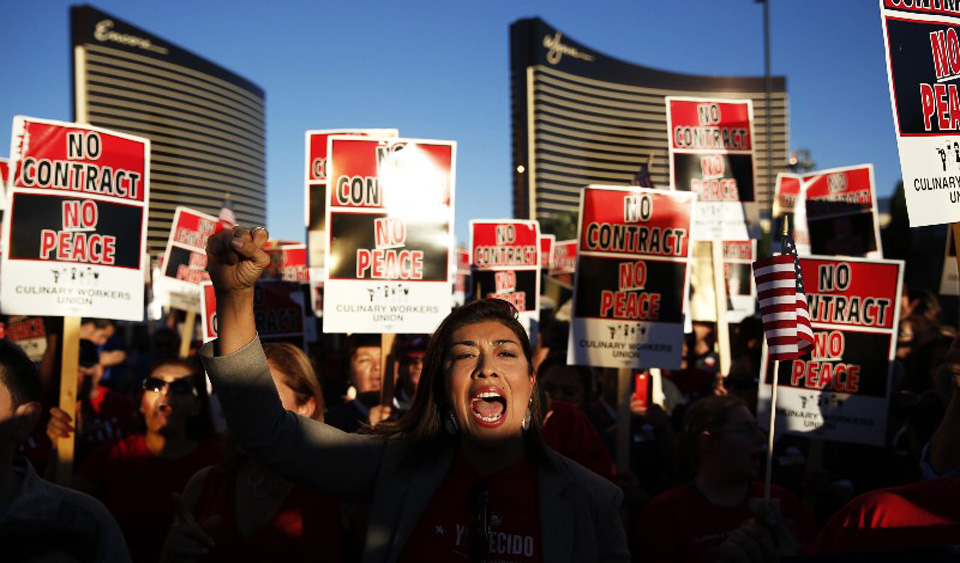
WASHINGTON – About a year ago, at the White House Worker Voice Summit, Vice President Biden cited the most powerful engine driving progress in America. “It’s a simple proposition,” he said. “With the ability [of workers’ unions] to sit on the other side of the table with employers and collectively bargain, [working people] have some power. At the end of day, that’s how progress is made.”
Collective bargaining is the only way to insure that employers will balance their need to make profits with the right of the workers who create those profits to have a decent, secure standard of living.
Unfortunately, once the election season began, no candidate has stressed how central building union bargaining strength is to the solving of many problems facing America.
Sure, just about all candidates – Republican as well as Democratic – have been echoing Bernie Sanders’ call to “make the economy work for everybody, not just those at the top.” But no candidate has clearly stated how to do this.
Solid historical evidence shows how: build the union movement.
When unions were strong, wage stagnation was practically nonexistent. In fact, when union membership reached its peak of about 30 percent of the workforce in the mid-1950s, hourly wages rose a bit faster than the rate of production. This was great for the country because working people spent more on consumer goods and services, which in turned spurred more production.
Then corporations mounted a long term strategy to smash unions. It began with red baiting and moved on to implementing the Taft Hartley Act, deregulating industries while slapping unfair regulations on unions, starving the National Labor Relations Board and making it increasingly difficult for workers to unite while making it increasingly easier for employers to undermine unionizing efforts.
There is a direct correlation between the undermining of unions, the rise of wage stagnation and the top one percent of the population ripping off the rest of us. Each year, as unions got weaker the rate of wage growth went down and the rich got a lot richer.
Today, union membership in the private sector has plummeted to 6.7 percent and 99 percent of al1 new wealth goes to the top one percent of our population.
As Vice President Biden said last year “This has happened because collective bargaining has been undermined. … business has declared war on labor’s house.”
Unions make us strong
Throughout her campaign, Hillary Clinton has said “When unions are strong, America is strong.” A comprehensive study by Harvard’s Bruce Western and Washington University’s Jake Rosenfeld quantifies exactly why:
Unions help all workers.
In places where union are strong, they set the floor – not the ceiling – for wages. Western and Rosenfeld report that “the economic benefits of a powerful labor movement redounded to unorganized workers as well as union members.”
Union membership spurs people to participate in government.
“A large body of research,” Western and Rosenfeld state, “has found that union membership spurs civic participation among non-elite Americans. … Unions helped to counteract class-based inequality in political participation, ensuring that elected officials heard the policy desires of millions of non-elite Americans.”
If union membership were larger, it is doubtful that the Republicans could have gotten away with passing so many voter suppression laws. In fact, unions are now in the forefront of fighting these laws.
Unions have been a force for racial, gender and ethnic equality.
“… throughout the second half of the 20th Century, many unions shed [their] racist and xenophobic legacies,” Western and Rosenfeld write.
“In so doing, they opened up their organizations to African Americans eager to escape explicitly racist policies and practices common to many nonunion workplaces. African Americans soon had the highest organization rates of any racial or ethnic group, peaking at more than 40 percent for African American men and nearly 25 percent for African American women in the private sector.
What’s more, “had no union decline occurred from the early 1970s on, black-white wage gaps among women would be between 13 percent and 30 percent lower, and black males’ weekly wages would be an estimated $50 higher.
Meanwhile, “many immigrants and their children, echoing pathways taken by newcomers in generations past, such as the predominantly female, predominantly immigrant population of the International Ladies’ Garment Workers’ Union, used the labor movement as a springboard into the nation’s middle class,” Western and Rosenfeld conclude.
I myself have seen first-hand the power of unions to build unity among workers of different races. In 1964, in Mississippi, at the height of violence against African Americans who were trying to exercise their right to vote, I helped black and white workers at a brick-making factory in Holly Springs to organize. They voted together to join a union.
No alternative to real collective bargaining
Many otherwise pro-worker political leaders are now promoting plans to “recognize” corporations that might not engage in collective bargaining but otherwise “treat their workers well.”
These leaders are missing the point. Without binding contracts reached through collective bargaining, employers can and do cut wages and withdraw benefits at will. The only way workers have a voice in their workplace and security on the job is through collective bargaining.
One of the challenges to union growth today is the rise of the so-called “gig” economy. There are some 68 million people who work part time, work only when their employers want them to work or who are classified by their employers as “freelance, self-employed independent contractors.” Many would rather be working full time. Many more lack insurance, cannot get overtime pay and live in poverty.
The gig economy employers are trying every trick in the book to make themselves exempt from labor laws that would require them to recognize unions.
For example, Uber “deactivates” their drivers for a wide variety of reasons, or no reason at all. It is now trying to get around labor laws by setting up a type of grievance board where workers can appeal deactivation decisions. But the company alone chooses who will serve on these boards.
In other words, nothing has changed for the drivers. Without collective bargaining their work lives are at the mercy of the whims of management.
Fortunately, the federal government, cities, some states and some courts are passing laws and regulations and issuing ruling granting part time and gig economy workers the right to form unions.
Union resurgence
These new pro-union laws, regulations and decisions are both a boost to union organizing and a reflection of the beginning of a resurgence in union growth.
As workers get together in unions, their voices are becoming more powerful in state houses and city halls. Political candidates are listening to them, too. The Democratic Party has pledged to promote the right of workers to join unions without inference from management.
Part of its platform reads “We will fight to pass[the Employee Free Choice Act] … that direct[s] the National Labor Relations Board to certify a union if a simple majority of eligible workers sign valid authorization cards, as well as laws that bring companies to the negotiating table.”
As a senator, Hillary Clinton was an original co-sponsor of the proposed Act.
Organized labor’s voice has been amplified, in part, because, as AFL-CIO Policy Director Damon Silvers said at a conference this past May, unlike in the past unions “cannot comprise with candidates. … The candidates we support must … be committed to the right of working people to organize and to bargain collectively.
“They must be committed to the idea that democracy must be wed to economic justice.”
As Vice President Biden said last year, “There’s a great resurgence taking place in the American economy, but we can’t keep the average American out of benefitting.
“That’s why we need more protection for workers’ rights.”










